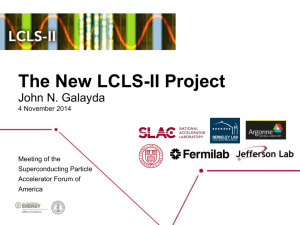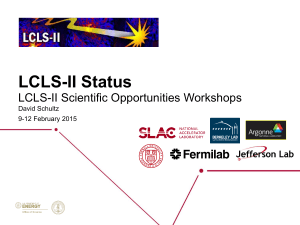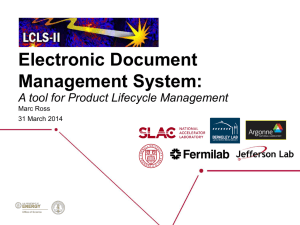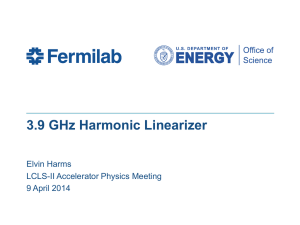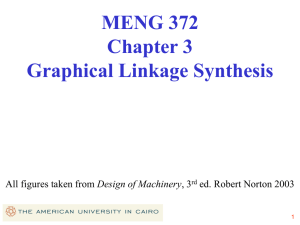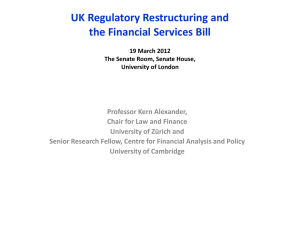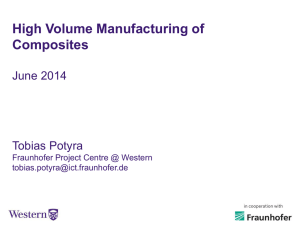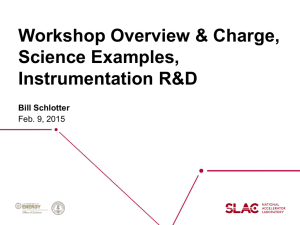AWLC14_SRFWFG_LCLS2_coupler_v2
advertisement
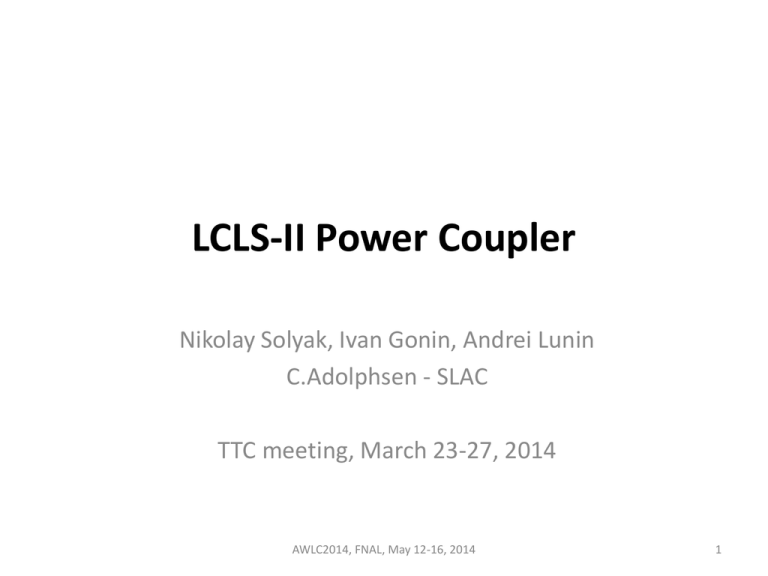
LCLS-II Power Coupler Nikolay Solyak, Ivan Gonin, Andrei Lunin C.Adolphsen - SLAC TTC meeting, March 23-27, 2014 AWLC2014, FNAL, May 12-16, 2014 1 Preliminary Item Design Max Input Power LCLS-II Coupler Technical Specs Spec Comment EuXFEL Coupler 2009 Drawing Package with exceptions noted below 7 kW CW Minimum Qext Foreseen 1e7 Maximum Qext Foreseen 5e7 Reduction in Antenna Length Range of Antenna Travel Predicted Qext Min Range Qext Max Range Warm Section Outer Cond Plating 8.5 mm +/- 7.5 mm 3.6e6 – 4.7e6 – 7.5e6 1.0e8 – 1.1e8 – 1.5e8 10 um +/- 5 um, RRR = 30-80 Assume would run with full reflection Allows 16 MV/m with no beam and 6.6 kW input, and allows 6 MW beams with 33 kW input Match for 0.3 mA beams at 16 MV/m, 26 Hz BW Maintain 3 mm rounding Range measured Assuming +/- 5 mm transverse offsets Nominal EuXFEL Warm Section Inner Cond Plating Cold Section Outer Cond Plating Center Conductor HV Bias 100 um +/- 10 um, RRR = 30-80 Modified – Temp Rise < 150 degC for 14 kW 10 um +/- 5 um, RRR = 30-80 Nominal EuXFEL Optional Use flex copper rings that can be replaced with existing capacitor rings if HV bias needed Warm and Cold e-Probe ports req No Do not expect multipacting at low power Warm Light Port Required Motorized Antenna RF Processing No Yes – max step = 50 um Do not expect arcs at low power Changes Qext by 1% 7 kW CW with full reflection – For initial couplers, use pulse power processing at vary reflected phase by 180 deg SLAC AWLC2014, FNAL, May 12-16, 2014 2 Fundamental Power Coupler (FPC) • XFEL (modified TTF3) coupler is not meet LCLS-II requirements – Tuning range (1.e6-1.e7) not cover required Qext=4.e7 – Overheating of the internal bellow in warm section at 7kW CW power at full reflection (effective power ~14kW) • Two modifications were proposed to address these problems (R&D program: Four coupler modification test) – Cut antenna 8.5mm to increase Qext – Increase copper plating of internal inner conductor of warm section from 30 μm to 100-150 μm to eliminate overheating TTF-3 design AWLC2014, FNAL, May 12-16, 2014 3 Inner conductor: Temperature distribution for different thickness of copper coating and different RRR (15kW, TW-regime) Tmax limit Data is simulated for RRR=10 Copper plating at inner part is 100 microns Conclusion: TTF3 Coupler need to be modified for LCLS-II. 100-150 μm Cu plating inner conductor in warm section of coupler is possible solution. AWLC2014, FNAL, May 12-16, 2014 4 LCLS-II Cavity Qext Computation Qmin LCLS-II specs Qnom Qmax Original coupler 1.106 3.5·106 1.8·107 Tip cut by 7 mm 3.8·106 1.6·107 8.5·107 Tip cut by 8.5mm 5.0·106 2.4·107 12·107 Nominal positions Q ext– range for ±7.5mm antenna tuning Antenna tip cut by 8.5 mm Original XFEL antenna Qext ~ 4.0·106 Qext ~ 2.4·107 R3 R3 AWLC2014, FNAL, May 12-16, 2014 A. Lunin, 12/13/13 5 Qext sensitivity to antenna displacements (ILC vs. LCLS-II) Horizontal LCLS-II Horizontal XFEL Vertical Vert. antenna tilt (up and down) XFEL Horiz. antenna tilt along cavity axis Qmin Qnom Qmax Original coupler 0.7·105 (3.0 .. 6.5) ·106 3.0·107 Tip cut by 8.5 mm 5.5·106 (2.3 .. 3.8)*·107 1.2·108 A.Lunin Conclusion • For LCLS-II coupler the most sensitive parameter is a horizontal antenna shift/tilt. • ± 5 mm shift change Qext by -5%/+50%. Vertical tolerances are relaxed. AWLC2014, FNAL, May 12-16, 2014 6 TTF-3 Coupler: Inner coating 30µm, outer coating 10µm. Helium cooling of the warm section 7kW TW TTF3 original I.Gonin (FNAL)coupler 7kW TW Helium, P=1atm Window force 160N Power Losses and max. Temp Ivan Gonin, FNAL TW TW power 2K, W 4K, W 80K, W Tmax K TTF-III as is 7kW 0.13 1.24 14.2 404 Helium, 1atm 7kW 0.13 1.27 17.3 316 LCLS2 (100µm) 7kW 0.13 1.25 15.5 326 LCLS2; 100/200µm 15kW 0.26 2.28 29.2/30 425/356 AWLC2014, FNAL, May 12-16, 2014 7 Full reflection: E-field distribution in LCLS-II coupler, Q=4e7, Pin=7kW AWLC2014, FNAL, May 12-16, 2014 8 Coupler operation at 7kW CW at full reflection PEC BC L L=0 LCLS-II Coupler. Inner coating 100µm. Outer coating 10µm Temperature distribution along surface of inner conductor for TW and SW ( L=0mm & L=65mm ) Maximum Temperature vs. L AWLC2014, FNAL, May 12-16, 2014 On resonance Tmax ~425K 9 Coupler test in HTS -1 Operational for ~5 yrs (~2 cavity/month throughput) – 1.3 GHz and 3.9 GHz cavities, ~1.5 ms and 9ms RF pulses – Now HTS upgraded for CW operation (commissioning) – Priorities in FY14 (CW regime) • • • • 10 HOM feedthu’s (XFEL and JLAB designs) 3 tests of high-Q0 dressed cavity (1 dressed to ILC helium vessel and 2 dressed to LCLS-II vessel) 2 modified at SLAC Power Couplers Integrated test of dressed cavity with Slow/Fast tuners, Frequency control and μ-phonics AWLC2014, FNAL, May 12-16, 2014 Active Magnetic shielding 500 mGs - 500 mGs Inside 1-layer magnetic shielding Max magnitude < 45mGs Inside 1-layer magnetic shielding after active correction by coils Max magnitude < 6mG AWLC2014, FNAL, May 12-16, 2014 11 HTS test preliminary schedule Test# and goals 1:HTS commissioning, HOM feedthru, μ-phon 2: High Q0 cavity #1 3: FPC cold modif, μ-phonics study 4: FPC modified; μ-phonics study 5: High-Q cav. #2 FPC#1 6:High-Q#3 integrated FPC#2 7: high-Q#2 integrated Tuner reliability Start 2014 Cav. type Helium Vessel HOM antenna Couple Coupler (cold) now RI26 ILC XFEL ILC non ILC XFEL ILC JLAB HQ#2 LCLS-II XFEL Sept.20 HQ#3 LCLS-II JLAB Oct.15 LCLS-II XFEL June 15 AES11 July 1 July 25 Aug 20 RI26 or AES11 RI26 or AES11 HQ#2 Assumptions about readiness: • 2 modified “cold” parts of FPC: April (done) • 2 modified “warm” parts of FPC: June Tuner RF (warm) Magn shield variable None 1L+coil Blade 50W variable None 1L+coil None 50W FPC modif FPC modif FPC modif FPC modif FPC modif FPC He cooled FPC#1 modif FPC#1 modif FPC#2 modif FPC#1 modif 1L+coil blade IOT 1L+coil blade IOT 1L+coil 2-layer 2-layer No tuner Lever tuner lever tuner IOT IOT IOT • 4 LCLS-II type of Helium Vessels: end of July • JLAB feedthru: end of June • New lever tuner and 2-layer shielding: Sept. AWLC2014, FNAL, May 12-16, 2014 12 Conclusion • XFEL coupler not meet LCLS-II specifications. Problems: Qext range and overheating • 2 major modification was proposed: shorter antenna (by 8.5mm) and thicker (>100μm) Cu plating of inner conductor in warm section to address these problems: • Modifications are in progress at SLAC (cold part modification was done, warm sections of couplers will be ready by the end of June 2014, plated at CPI and processed at SLAC). • HTS tests is essential part of design verification program for LCLS-II. – 3 high Q0 (N2 doped) integrated tests , (HOM feedtru’s, FPC, Helium vessel, Tuner, magnetic shielding) – two modified FPC assembled on high-Qo cavity. • Next step: start FPC procurement after HTS tests. – Documentations and review. AWLC2014, FNAL, May 12-16, 2014 13
